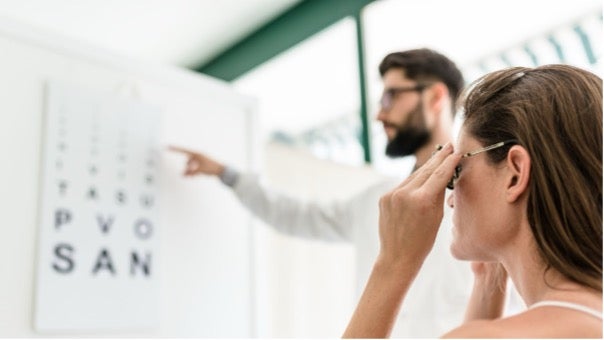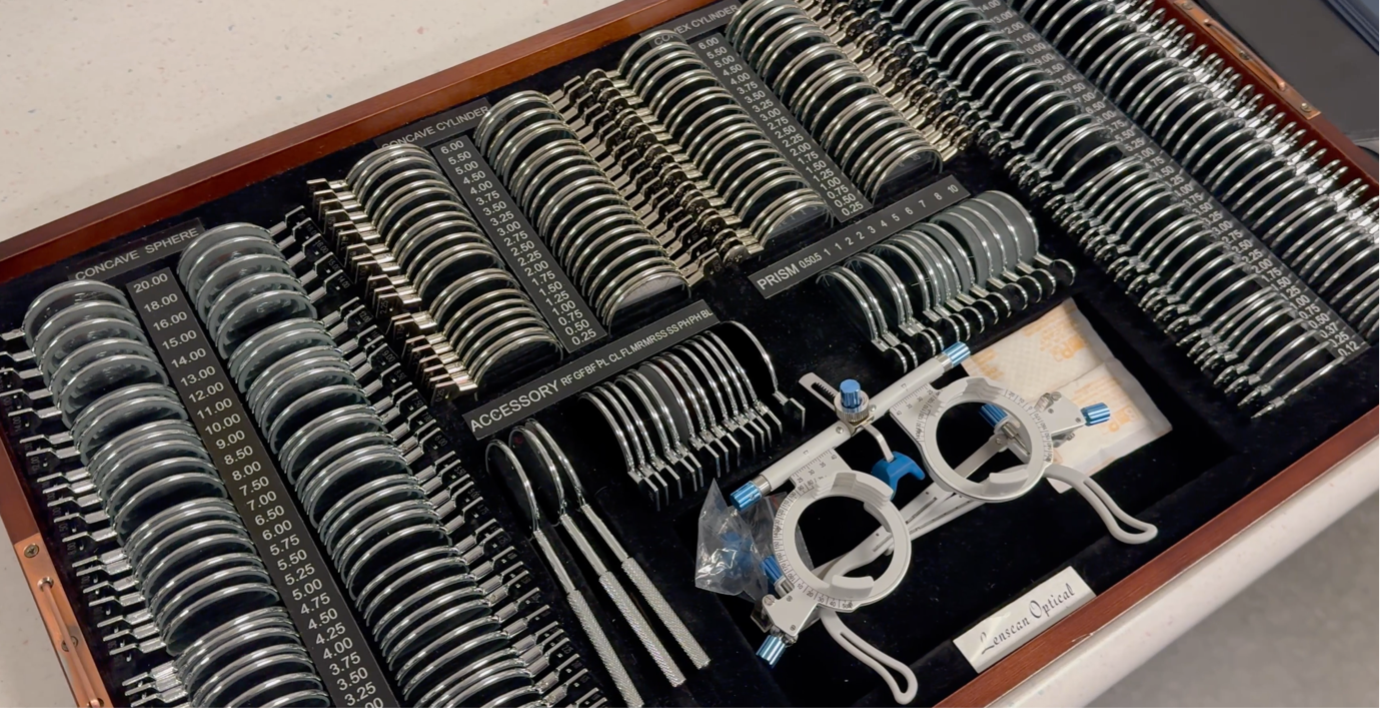What is myopia?
More commonly known as nearsightedness, myopia is a vision condition that causes distant figures to appear blurry while items close by typically remain clear. This occurs because the eyeball has elongated and light entering the eye focuses in front of the retina instead of on the retina.
Over the years, prevalence of the condition has increased and shifted towards developing earlier in life. Currently, it is common to see signs of myopia in children as young as seven or eight. Myopia in children usually progresses, with the child’s prescription getting higher and higher. Once they reach adulthood, progression typically stops.
In adulthood, severe nearsightedness, or high myopia, puts people at higher risk for serious eye conditions, such as retinal detachment, glaucoma and cataracts, that can cause vision loss.
Causes
There is not one direct cause of myopia. However, there are genetic risk factors. Children of parents with myopia are more likely to develop myopia themselves. Additionally, children of Asian descent are far more likely to have myopia than white children. In terms of environmental risk factors, it has been found that children who spend less time outside and more time on digital devices are more at risk of developing myopia.
Symptoms
By far the most common symptom reported by adults is that distant objects have become blurry and difficult to read. Other symptoms may include:
- Squinting
- Eyes feel sore or tired
- Headaches
Young children often do not notice any symptoms as they have grown accustomed to their blurred vision and are unlikely to remember a time when their vision was clearer. This is one reason why it’s so important for children to have routine eye exams, so that an optometrist can catch the vision error, that would otherwise go unnoticed, as early as possible.

Diagnosis
An optometrist may diagnose a patient with myopia during a routine eye examination. The optometrist will perform visual acuity tests using tools such as the Snellen chart, where patients are asked to read aloud the smallest row of letters that they can discern at a distance. Alternative tools are used for children who can't read yet. These tests help the optometrist to establish how far a patient can see before shapes become too blurry.
Then, using a phoropter, an instrument that allows an optometrist to flip between lenses and ask which makes the patient’s vision clearer, the optometrist will determine an accurate prescription and what lenses are necessary to correct the patient’s vision.
If determined that the patient has myopia, an optometrist will complete a couple additional tests. For instance, it is important for optometrists to measure the axial length of the eye – that is, the distance from the cornea to the back of the eye. Since myopia occurs due to the elongation of the eye, understanding the length of the eye can support the diagnosis as well as inform future eye appointments by comparing the current length to past lengths. This will help determine whether the patient’s condition is continuing to worsen or plateauing.

Treatment
It is crucial that children with signs of myopia begin treatment as early as possible. These young patients can use myopia control lenses, which aim to slow the progression of myopia, as opposed to standard lenses, which use optics that focus light behind the retina, signalling the eye to continue to grow. This leads to the child’s condition worsening. Instead, myopia control lenses shift peripheral light in front of the retina or reduce peripheral contrast to avoid creating this signal for the eye to continue to elongate.
Progression of myopia generally cannot be reversed, so intervening early allows the patient to avoid a much higher prescription later in life. Myopia control treatments unfortunately do not work in adults.
Myopia control lenses are available as soft contact lenses, hard contact lenses or spectacles. In addition to helping to prevent the progression of myopia, these optical devices correct the patient’s vision so they can be successful at daily living tasks.
Myopia control can also be achieved through medicated eye drops taken at night before bed. Children who use these drops for myopia control may still need to use glasses or contact lenses to correct their vision during the day.
All these options have roughly equal levels of effectiveness, so deciding between them is a matter of personal preference depending on which is most compatible with the patient’s lifestyle. For instance, for an athletic child, glasses may not be the right choice and they may opt for contact lenses or eye drops instead. Patients can also use a combination of these treatments. Overall, it is important to have an open discussion with an optometrist about which method of treatment would be best for the patient.

Waterloo Eye Institute patients
The Waterloo Eye Institute offers comprehensive eye care to people of all ages. A primary eye exam will not only cover visual acuity, which will determine whether you have a condition such as myopia, but also your eye health and binocular vision – your eyes’ ability to work together.
We offer a pediatric service for children under seven where slightly different tools are used to accommodate children who are unable to read or understand directionality. For example, instead of a Snellen chart, a pediatric optometrist may use a sheet of paper with a faded image in the corner. This will allow the optometrist to see if the child is able to see the image by following where their eyes land on the page. Having these tests accessible to young children is important because conditions such as myopia can begin to develop in children at a young age. The earlier we catch these conditions and begin treatment, the better.
If you would like to book an appointment for yourself or your child, you can book a comprehensive eye exam online or call 519-888-4062 to speak with a patient care coordinator who will set up an appointment for you.
Children 19 and under and seniors over 65 are typically eligible for annual eye exam coverage through the Ontario Health Insurance Plan (OHIP). The fee for a comprehensive eye exam not covered by OHIP is $120 as of 2024. Discounts apply for University of Waterloo employees, students and their dependents. Occasionally, once myopia has been diagnosed, there may be supplemental fees for additional testing.
Myopia Control
To slow the progression of myopia in children, whether through specialty contact lenses, spectacles or eyedrops, patients must go through the Waterloo Eye Institute’s Advanced Contact Lens Service. To book an appointment at the Advanced Contact Lens Service, call 519-888-4414. Appointments at our specialty services are not available to book online. Additionally, Advanced Contact Lens Service appointments require an internal referral from our Primary Care Service or an external referral from your regular optometrist.
Optical Dispensary
If you need glasses, whether myopia control or regular optical correction spectacles, the Waterloo Eye Institute is also home to the Optical Dispensary, where you can find the right eyewear for you. Appointments are prioritized and highly recommended and can be booked online or over the phone at 519-888-4733 (Waterloo Main Clinic) or 519-888-4455 (Kitchener Health Sciences Optometry Clinic).
Research
The University of Waterloo School of Optometry and Vision Science is ranked fifth worldwide in research output for schools of optometry. Within the School is the Centre for Ocular Research & Education (CORE), which produces an abundance of vision research, especially relating to contact lenses.
CORE is widely known as a centre of excellence for myopia research. Supporting this claim is a 2019 study where Dr. Debbie Jones, a lead CORE clinical scientist, was a lead investigator of the Canadian site for a pivotal study in myopia. This study has since resulted in FDA approval for a soft contact lens that slows progression of myopia over time.
Interested in participating in research? Find participation information for current CORE studies. For more general research volunteer information, check out our current studies recruiting participants.